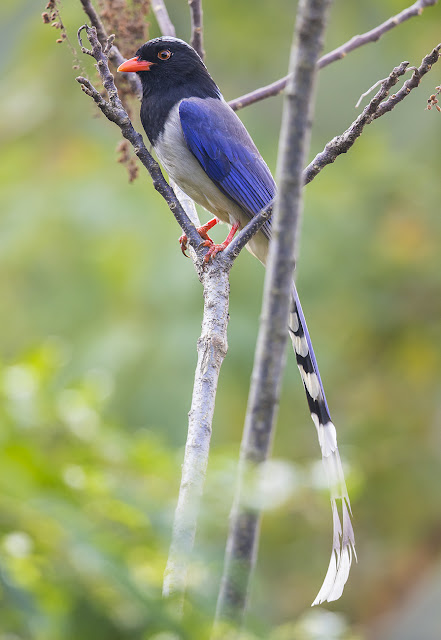Slaty-backed Forktail - last addition to my year list
I was looking through my 2017 bird record near the end of December and I couldn't help noticing how enticingly close my year list is to 300 species. I've never gotten past 300 species in a year before, so this became a little goal to aim for during the last month of 2017. A few days before the new year and when I recounted my records I noticed I was up to 304 species, naturally I would love to squeeze out what is left in the year.
The most obvious target of mine was the Chestnut-crowned Warbler at Lung Fu Shan which I have already missed on two occasions. I was determined to nail this bird, and after some encouragement from fellow birders I gave this bird a third try. It was third time lucky, as I located the bird by it's faint high pitched call, and soon found it feeding amongst a few Pallas's Leaf Warblers, it's bright yellow underside and greyish throat and breast was pretty unmistakable. The bird later came down to eye-levels and gave some really good views! Therefore completing my Lung Fu Shan duo of both Small Niltava and Chestnut-crowned Warbler. So that was my 305th species.
Chestnut-crowned Warbler - third time lucky!
On the 30th I decided to add one last species onto my year list, a Slaty-backed Forktail that had been around the stream next to picnic area 7 at Shing Mun Reservoir and was my best bet for adding one last species. I arrived quite early that morning, on the way picking up a bird wave with a single male Verditer Flycatcher as highlight. I also encountered a large flock of Indochinese Yuhinas which gave close views.
Verditer Flycatcher - male
Indochinese Yuhina
The walk to picnic area 7 took nearly 40 minutes, there was no sight of the Forktail when I arrived, so I sat down and waited. It wasn't until 9:30am that the Forktail finally showed itself, as it flew in and foraged along the tree trunks and rocks for a few minutes before flying off once again. It was a long time ago since I last saw one in Hong Kong, back when one regularly visited the stream at Tai Po Kau. Although I see this species a lot in Guangdong in similar habitats, they have never took off in Hong Kong somehow and remains to be a rare occasional visitor. Why that is we may never know, but I certainly hope we get them in Hong Kong more regularly, as they are awesome looking birds, and very happy to get it as my 306th species of the year.
Slaty-backed Forktail - mysteriously rare in Hong Kong
My last day of the year was spent at Long Ke Wan, I was doing a nature tour as part of an land art camp organised by Art Together. The camp allowed participants to experience and create art in nature, there was a kite making session with natural materials which everyone enjoyed immensely. The area around Long Ke Wan is extremely scenic, situated within the Hong Kong Geopark, it is certainly one of the most beautiful places in Hong Kong. We even hiked up the hill to look at the first sunrise of 2018 to start off the year!
Kites made with found twigs
Feral Cattles are commonly found around Hong Kong's country parks
Beautiful area around Long Ke Wan
1st Sunrise of 2018
The area is not a birding hotspot, as it's surrounded by mainly scrubland, I heard a few Brown-flanked Bush Warblers and Russet Bush Warblers around the surrounding hills. A very friendly Blue Rock Thrush of the race pandoo was one of the better birds I found in the area, I usually see race philippensis, pandoo seems to be far less common in Hong Kong.
Blue Rock Thrush - male ssp. pandoo
For the nature tour, I took the participants on a short walk around the camp site, looking for birds and other interesting creatures around us. We were very fortunate to get a very cooperative Common Kingfisher which fished in the small lagoon, everyone gave a lot of "oooo's" and "ahhh's" when it dived for fish right in front of us. The most impressive bird though was probably a pair of White-bellied Sea Eagles duetting loudly on the surrounding hills, a species that I find to be the most impressive looking bird of prey in Hong Kong. They are most likely a pair breeding in the area, although I am not sure whether they have a nest yet or simply trying to find a suitable place to build one. Either way they certainly impressed the participants as much as they impressed me.
Looking at the Common Kingfisher
White-bellied Sea Eagle - a beautiful pair


















































